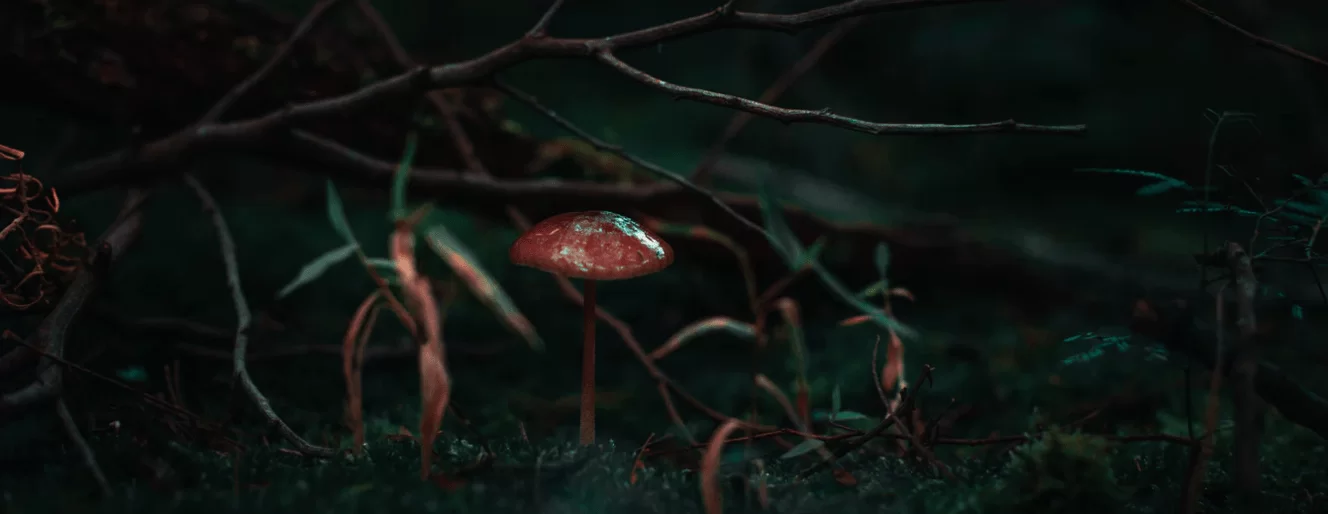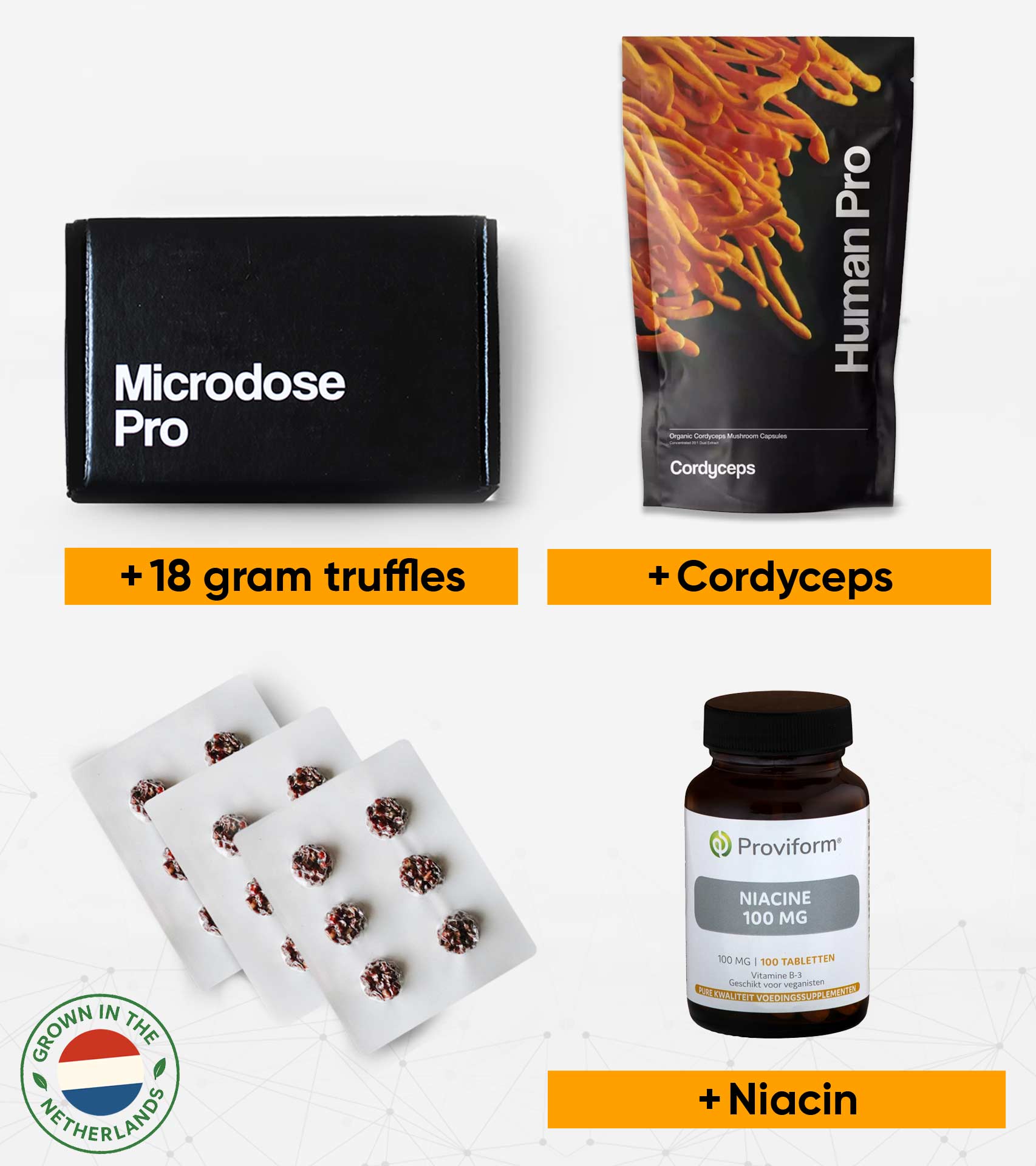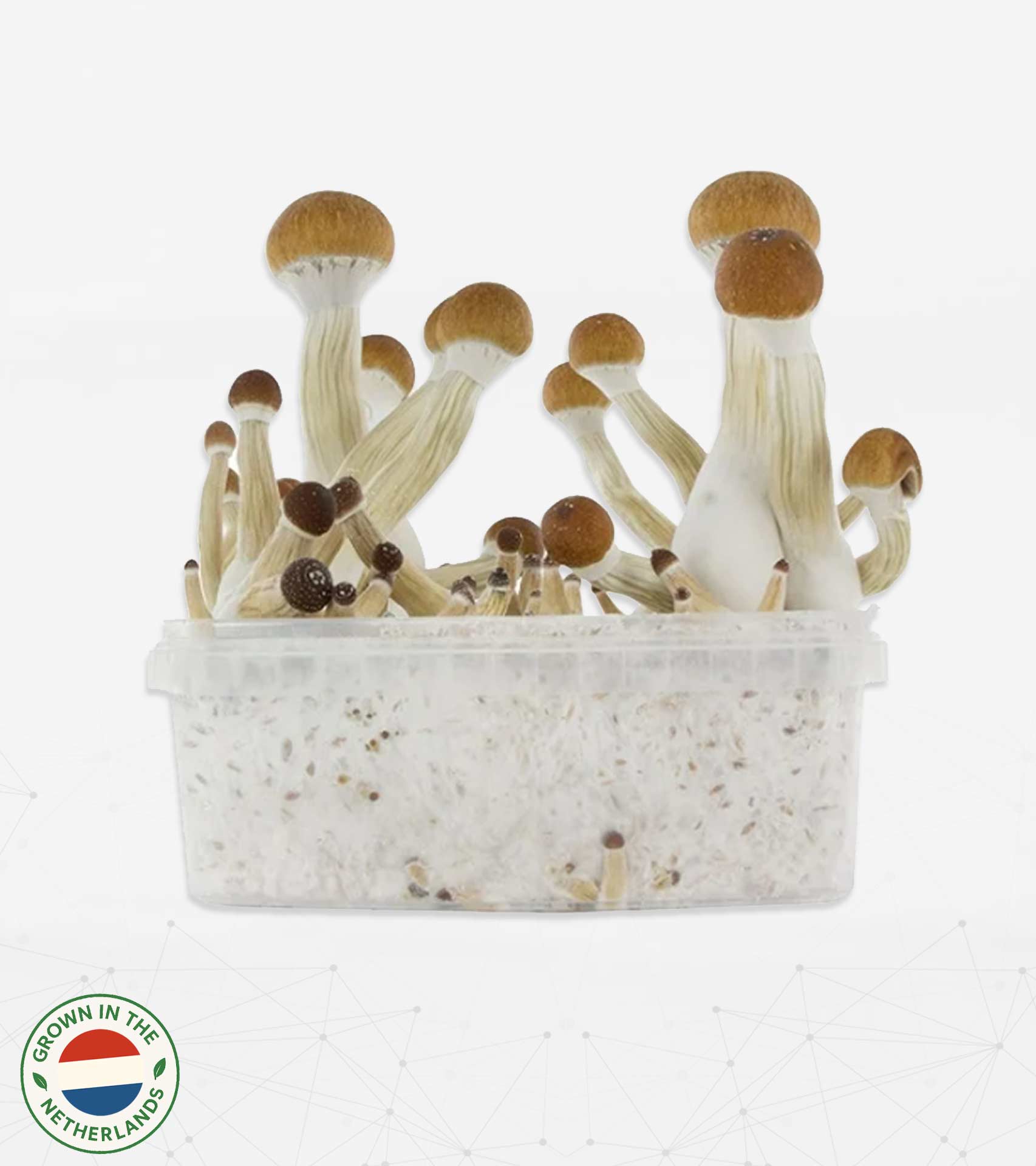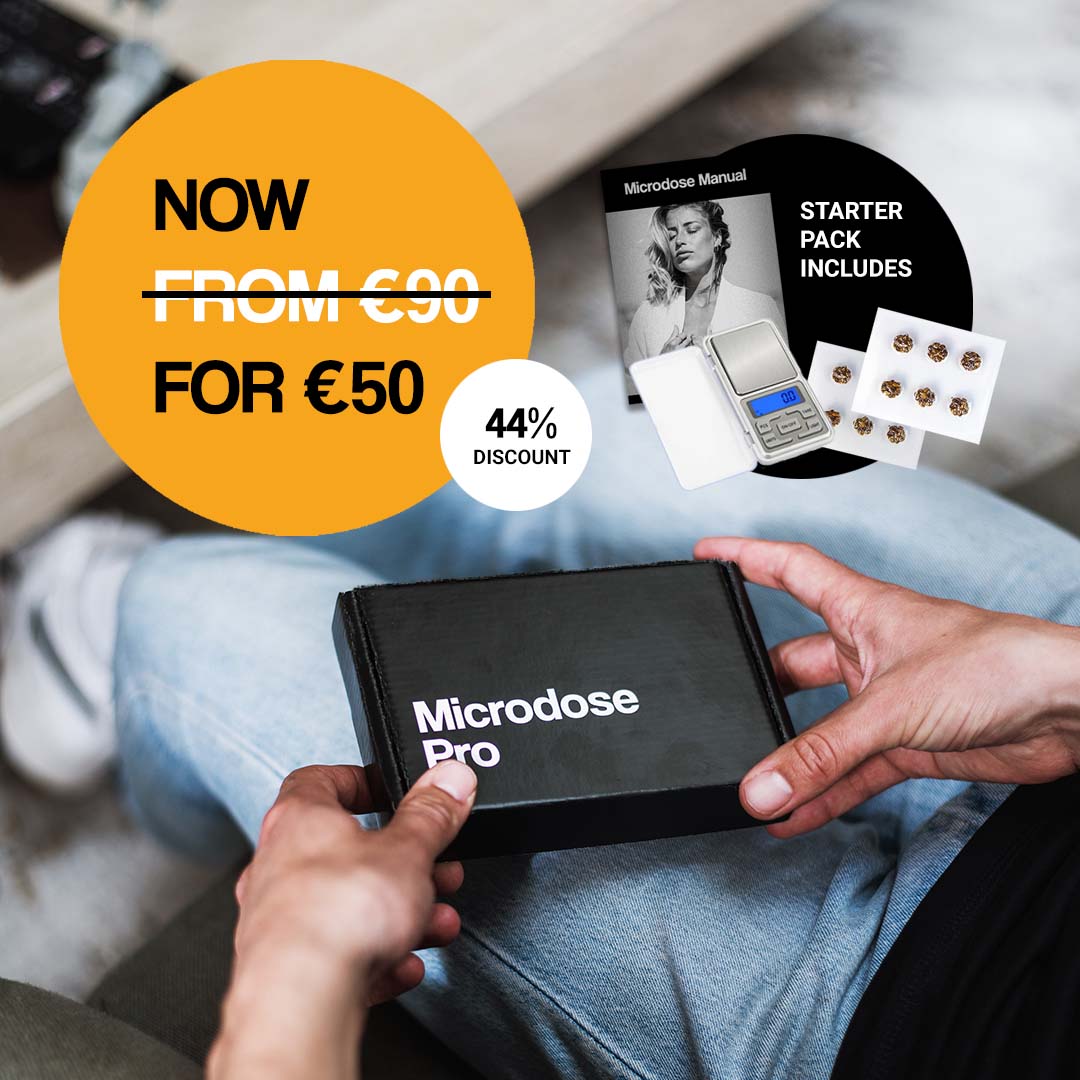With legislation likely to loosen around psilocybin in the next few years, we examine exactly what this psychedelic substance is, and does.
Microdose Pro is a brand built around the practice of microdosing psilocybin using pre-packaged packs containing psilocybin-rich truffle tissue. We launched the brand for three key reasons: firstly, we felt there was a major gap between the lifestyle trend of microdosing and what the general public knew about it. Secondly, we were fascinated by the effects psilocybin has been shown to have on both physical and mental performance, and wanted to make this experience more widely accessible.
Thirdly, we assessed the accelerating push-back against the legislation around another substance, cannabis, and projected that psilocybin will probably be legalized in the USA, Canada, and Europe within the next ten years (psilocybin truffles are already legal here in the Netherlands).
What is psilocybin?
Psilocybin is a naturally occurring psychedelic compound produced by a number of different fungi species. By “psychedelic”, we mean that it has the ability to alter human consciousness when consumed, because it mimics the behaviour of existing neurotransmitters in the brain at a heightened level. Other natural psychedelics include iboga, mescaline and, of course, cannabis. There are also artificially-manufactured psychedelics, the most well known being LSD and derivatives thereof.
In 1959 Swiss chemist Albert Hofmann first isolated psilocybin from within the mushroom species Psilocybe mexicana. Hofmann’s employer, Sandoz, proceeded to bottle and sell psilocybin to physicians and clinicians around the world for use in psychedelic psychotherapy. That was until, around the close of the 1960s, the law began to tighten on psilocybin and other psychedelics, and the promising exploration of its benefits to therapy was largely curtailed as the “war on drugs” took hold.
This was a pity since psilocybin, along with other natural psychedelics, had been in use since prehistoric times in various spiritual ceremonies – a practice now at odds with the views of late-20th-Century conservative America, which was largely responsible for driving the global clampdown on psychedelics.
Throughout the next few decades, DIY mushroom-growing lore spread around the world despite the long arm of the law. People on the fringes of society – and no doubt a number of discrete medical researchers – continued to quietly experiment with the psychoactive properties of psilocybin.
In 2 000, the USA’s respected Johns Hopkins University initiated a series of now-renowned psilocybin studies and the compound began to slowly creep its way back towards the mainstream, buoyed by renewed interest amidst the work of vocal psychedelic researchers like Terrence McKenna and mycologist Paul Stamets. By 2011 social media, online psychedelic chat forums, and widely-read books, like Dr. James Fadiman’s The Psychedelic Explorer’s Guide, were rapidly furthering awareness of psychedelics, psilocybin – and its role in an intriguing activity called “microdosing”.
What is microdosing?
Microdosing is a fast-growing subculture whose members consume very small amounts (literally, micro amounts) of a psychedelic substance or substances, every few days for several weeks – to reduce anxiety, alleviate depression, sharpen focus, improve creativity, heighten the senses, make socializing easier, raise energy levels – or any combination of these aspects of being.
In general, microdosing involves taking about one-tenth of the usual “recreational” dose of a psychedelic, leading to only a mild effect on the brain, rather than a dramatic “high”. This more disciplined approach to using psychedelics than had been seen before arguably imbued them with an improved public image and has led more people in the “mainstream” to experiment with microdosing. Medical professionals, too, feel more comfortable researching psychedelics at the microdosing level and many now argue, in particular, for the decriminalization of psilocybin within psychiatric therapy.
Where do you find psilocybin?
If you Google “psilocybin” 99% of the content the browser pulls will still be about psilocybin mushrooms, also called “magic mushrooms” or just “shrooms”. Not too many people talk about psilocybin truffles as yet, yet they too contain the same compound. Let’s discuss both the mushrooms and the truffles.
Psilocybin mushrooms
Psilocybin or “magic” mushrooms are small mushrooms with long, pale stems and light- to mid-brownish caps. They go by many names including shrooms, liberties, amani, agaric, mushies, blue meanies, golden tops, liberty caps, and philosopher’s stones. It can be easy to mistake them for ordinary mushrooms, but magic mushrooms often have a telltale lacy white ring or collar high up on the stem and quite long, steeply-sloping caps. This guide shows what some of the most notable species of wild magic mushrooms look like.
Over time, hundreds if not thousands of different types of psilocybin mushrooms have been observed, within 11 broader genera, or biological class.This world map shows where the mushrooms are most commonly found growing. They tend to flourish in soil that is rich in humus and plant debris, and in humid subtropical settings.
Psilocybin mushrooms and mankind have a long history. They have been recognized in Stone Age rock art in Africa and Europe from as far back as 7 000 BC, and in ancient sculptures and glyphs from throughout the Americas. In October 2007, magic mushrooms became prohibited in the Netherlands.
Psilocybin truffles
Psilocybin truffles are quite different from the culinary truffles served up in fine dining, which are more accurately a kind of (very expensive) tuber. Psilocybin truffles are actually underground nodes of psilocybin mushrooms which the fungi use as food reserves when growing conditions above ground become too difficult. In form, the truffles are tough little clumps, harder and dryer than the mushroom stems and caps above ground. Like the mushroom tissue, they contain the compounds psilocybin, psilocin, and baeocystin, but usually in lesser quantities than you’d find in the mushrooms.
There are various types of magic truffles including Psilocybe hollandia , Psilocybe atlantis, the Philosopher’s stone (Psilocybe tampanensis), Psilocybe pajaritos and Psilocybe mexicana. Since September 2019, magic truffles have been fully taxed and legal in the Netherlands.
How does psilocybin work?
Deep inside the human brain is a region called the “claustrum”. It’s a cluster of neurons that is linked to almost every other part of the brain. Some researchers postulate that the claustrum is the seat of consciousness, awareness, and sense of self – in other words, this is the part of the brain that causes us to think and worry about ourselves, our health, our future, our social standing, and recently published research by Johns Hopkins University showed that psilocybin, when met by receptors in the claustrum, subdues the level of activity in the claustrum.
This would logically cause an individual to become less self aware and more aware of everything else around them. That explains why people report their worries “melting away” after taking psilocybin, or relate how they became incredibly interested in the natural world, or a task or activity for a while – they were no longer worrying about themselves and could more easily become absorbed in other things. Research has also shown that psilocybin can dis-organise rigid neural pathways in the brain, so that the brain starts thinking in new, rather than habitual, ways.
Psilocybin in health care
Studies have shown that psilocybin can help the brain to become more “open” to new experiences and to more free-flowing trains of thought. For this reason, some researchers think it could be a useful therapy for obsessive compulsive disorder (OCD), in which sufferers can’t help thinking, or doing, the same things repeatedly all day long – updating their diary; cleaning; washing hands; checking where their personal belongings are, etc.
Consuming psilocybin has also been shown to reduce anxiety and depression – this effect was particularly noticeable in a study, published in 2016, which found that hospital patients suffering from clinical anxiety and depression caused by their life-threatening cancer diagnoses reported an improvement in their mood, both right after taking psilocybin and even six months later.
This may well have something to do with the way that psilocybin represses the ego or self-awareness in the claustrum; the individual largely “loses” the ability to worry about themselves for a time.
Ongoing research points to psilocybin (which is itself non-addictive) being of potential benefit in helping individuals “kick the habit” of addiction to nicotine, cocaine, or alcohol – perhaps because of its ability to disrupt anxiety or depression, which often lead people to self-medicate, as well as its ability to disrupt habitual, repetitive behaviour (even smoking or drinking are arguably forms of OCD). Delve more into this intriguing aspect of psilocybin here.
What happens when you microdose psilocybin?
In microdosing psilocybin, the effects are very mild because the dose is very small; you would be likely to experience only minor changes to your mental activity – minor enough so that you would be able to carry on with your day more or less as normal. As The Third Wave puts it, microdosing “seems to offer a promising path to reaping the benefits of flow on an everyday basis without the cost of time and energy that full-blown trips usually incur”. Some of the most commonly reported outcomes of microdosing psilocybin include:
Increased focus and productivity
Many microdosers report that psilocybin helps them to get into a “flow” state, where they are able to work, work out or pursue creative endeavours for hours on end, without getting distracted. As Microdose Pro co-founder Nils Paar recounts in his microdosing log:
“High levels of focus, energy, and attention on the task at hand. It was easy to reach a flow state. I worked for 10 hours straight with a lot of context switching between client calls, meetings and deep work sessions. Usually all this demands a lot of mental capacity, but today it felt natural and effortless. In addition, I performed a 24 hour fast – didn’t eat the entire day – which was beneficial for staying in flow. One of my most productive days of the year so far.”
Improved mood
In many studies, an improvement in mood is cited as the most noticeable effect of microdosing psilocybin. Psilocybin behaves in the same way as serotonin, a neurotransmitter in the brain that stimulates feelings of love and happiness. What’s intriguing about this aspect of psilocybin is that researchers have found that it can not just lift an individual’s mood at the time; it may also sustain their improved mood over an extended period of time, as a study of more than 1, 200 psychedelic-using festivalgoers found. This “afterglow” effect has also been observed in patients suffering from life-threatening cancer, in hospitals, who report improved mood sometime after the day they microdosed.
Enhanced creativity
As outlined earlier, psilocybin has the ability to “dis-organize” thought patterns and increase an individual’s level of “openness”, allowing their thoughts to free-flow in new directions. This ability, also shared by LSD, explains to a degree why psychedelics have proved so popular over the decades with writers, artists, and musicians. However, “creative” thinking can also be useful in tech, business, or other “non-creative” settings – tech hub Silicon Valley has become a hotbed of microdosing in the last decade and a lot of our own customers are young business people or entrepreneurs.
Better social skills
Again, this is probably because of psilocybin’s ability to suppress a focus on ego in the brain, which helps those who microdose it to feel more comfortable in their own skin and less sensitive to the opinion of others. As Janet L. Chang relates in her blog, “I woke up after my first dose of mushrooms to find my lifelong fear of public speaking gone” and, “I was more comfortable in public, and less anxious in conversations. Although I already considered myself open-minded and accepting, I became more tolerant and compassionate towards people“.
What are the health risks of microdosing psilocybin?
Too much psilocybin is certainly not a good thing – you can technically overdose on magic mushrooms and experience intense difficulties, although you are unlikely to die. Symptoms of having too much psilocybin can include anxiety and panic attacks, vomiting, seizures, paranoia, and, in extreme cases, coma. Find out more from the Alcohol and Drug Foundation.
By logical inference, you could overdose on magic truffles in the same way, although you’d have to consume a large amount for that to happen. In microdosing, and especially when microdosing truffles, the dosage is so small that a significant impact on physical or mental health is unlikely.
Some microdosers have reported mild ups and downs during their microdosing, such as an increase in anxiety. Nils Paar again: “For the last few months I have been … taking on more and more tasks and, today, I felt more anxious with the workload than usual … this leads me to believe that microdosing enhances negative emotions (if present) as well as positive ones.”
In summary, it is important to stick to the recommended dosage level of psilocybin, which is 0.5 – 1 gram, and to avoid microdosing on days when you are feeling anxious or overly-agitated. You should also take a few weeks’ breaks between microdosing phases, so that you don’t form the habit – mentally, rather than physically – to be microdosing at all times.
How do you microdose psilocybin?
The easiest way is simply to order our magic truffle Pro Packs, which are pre-packed and contain the standard one gram of truffle per microdose, with six microdoses per strip – exactly what you’d need for a three-week microdosing phase (some of our fans buy two packs at a time, in order to microdose for a six-week phase).
The farm that produces our truffles engineers them to have an even spread of psilocybin throughout the truffle tissue; truffles obtained elsewhere may vary in psilocybin density. If you find or buy truffles in their original wild form, you would need to grind them into a fine powder; you can do this with a little mortar and pestle. You would also need a scale that can accurately measure grams and micrograms.
If you microdose with mushrooms, the dosage levels are roughly 0.1 – 0.5 grams for a microdose and 0.5 – 2 grams for a low “recreational” dose. Up to 3.5 grams is a moderate dose. With 3.5 grams or more, you would become “high” at some level. These measurements are for dried Psilocybe cubensis mushrooms, and are put forward by Michelle Janikian in Double Blind. She emphasizes that other mushroom species may differ in strength and also that, if consuming fresh magic mushrooms, you should multiply the above dosage levels by ten to account for water content in the mushrooms. If you aren’t sure what dosage to start with always start low, rather than high – then see how you feel.
To consume microdosed psilocybin, you would simply eat the fresh or dried mushroom tissue or powered mushrooms or truffles. Not everyone likes the taste of magic mushrooms or truffles and you might find it more pleasant to mix your microdoses into a glass of water or juice (we don’t recommend mixing alcohol and microdosing). You can also empty powdered truffle or mushroom into empty gelatin capsules and swallow the capsules.
Psilocybin and the law
Magic mushrooms are illegal in the Netherlands and many other countries. While the truffles are not illegal in the Netherlands, they are in most other countries – where the penalties for being found with psilocybin in either form can be quite serious. At Microdose Pro we specifically advocate responsible use of psilocybin-containing truffles for microdosing, where it is within the law and if you are aged 18 or older.
Before you consider microdosing mushrooms or truffles, first research their legal status in your country. Here is a basic list of the legal status of psilocybin mushrooms in a number of countries (many countries apply the blanket same law to both mushrooms and truffles). Here’s a more detailed overview – note the little green Netherlands on the world map! The legislation is endlessly variable, depending on where in the world you are, so if in doubt, check with your local authorities.
Thank you for reading about the fascinating and intriguing compound psilocybin. If you’d like to go into a bit more depth, have a look at our sister article on truffles and, to find out about microdosing other psychedelics, you may enjoy this microdosing overview.
Sources:
https://medium.com/better-humans/how-one-year-of-microdosing-helped-my-career-relationships-and-happiness-715dbccdfae4
https://www.inverse.com/mind-body/how-do-magic-mushrooms-affect-the-brain
https://www.psytech.biz/the-netherlands-is-psychedelic-friendly/
https://www.sciencedaily.com/releases/2020/06/200605121512.htm
https://www.verywellmind.com/what-are-magic-mushrooms-22085
https://www.iflscience.com/health-and-medicine/psychedelic-drugs-can-help-alcoholics-stop-drinking-according-new-study/
https://www.medscape.com/viewarticle/924368
https://www.thecut.com/2018/05/microdosing-guide-and-explainer.html
https://www.wweek.com/culture/2017/04/18/i-tried-microdosing-with-four-different-psychedelic-drugs-heres-what-happened/https://www.wired.com/story/a-microguide-to-microdosing-psychedelic-drugs/
https://maps.org/news/bulletin/articles/383-bulletin-winter-2014/5430-my-experience-as-a-guide-in-the-johns-hopkins-psilocybin-research-project
https://sites.google.com/view/microdosingpsychedelics/home
https://en.wikipedia.org/wiki/Drug_policy_of_the_Netherlands
https://thethirdwave.co/microdosing
https://en.wikipedia.org/wiki/Microdosing




